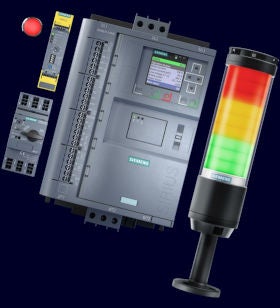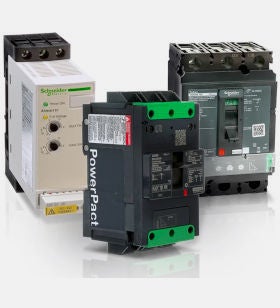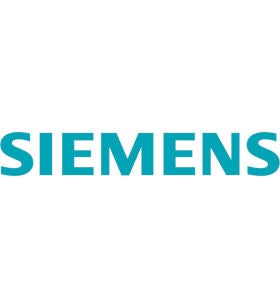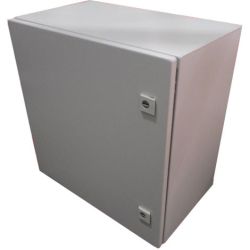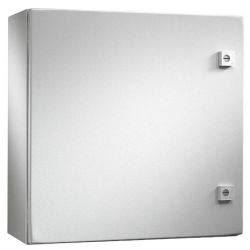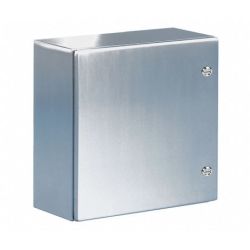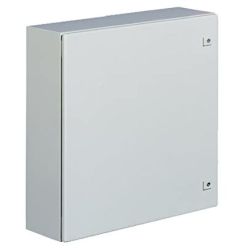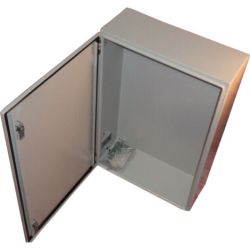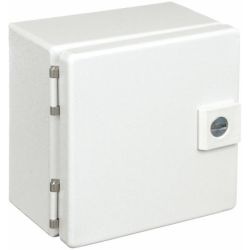FAQs About Modular Enclosures
Once you understand the benefits of modular enclosures, you will want to choose them for almost every application. To help you better understand this style of industrial enclosure and overcome common misconceptions, here are some common questions Rittal gets from assemblers and installers.
Can modular enclosures actually support mounted accessories?
Yes! Modular enclosures use a frame-based design for increased rigidity and durability compared with traditional unibody enclosures, which rely on thicker construction material to carry the additional load of mounted accessories like a cooling unit. In addition, because modular enclosures rely on an internal frame system for support, they can be built using a thinner construction material - 14 or 16 gauge sheet steel - that allows for simpler, faster customization like cutouts without the need for specialized tooling.
Even with the thinner material, the frame based design of the Rittal TS 8 still allows for a maximum weight capacity of 3,150 lbs.
Do I need specialized tools to assemble or install a modular enclosure?
You do not. In fact, standard tools commonly found in any shop will do the job. Here is a list of the only tools you need to assemble, install, or customize a modular enclosure like the Rittal TS 8.
- T25, T30 & T40 Torx Bit or Wrench
- 8mm Metric Socket
- 8mm Metric Hex (Allen) Bit or Wrench
- Flat blade Screwdriver
- Light duty Hammer
Are not cut-outs messy and difficult to execute with a modular enclosure?
Not at all. Because modular enclosures use an internal frame structure as support for the panels, electronic controls inside the enclosure, and any mounted accessories, thinner construction material allows assemblers and installers to complete cut-outs, holes, or drilling on a simple workbench without the need for any internal cleaning of the enclosure. The panels can be removed making it easier to make the necessary modifications. For increased automation in the milling and modification process, Rittal Automation Systems automated machines help to provide repeatable and accurate cutouts with the Perforex MT or the Perforex LC. Plus, consistent mounting services and thin gauge construction material makes it fast and easy to fix any errors in the manual tooling of the enclosure, which helps to reduce downtime and maintenance costs.
Does a modular design mean I can have additional doors?
It does. The interchangeable nature of door hinge assemblies allows the rear panel of the enclosure to be replaced with a door for superior customization and flexibility of configuration. The substitution of the rear panel with an additional door also makes it easier to access and customize interior mounting panels from the rear of the enclosure. Dual access to the interior of the enclosure is key in manufacturing facilities with limited space or unique deployment scenarios.
Are modular enclosures well-suited for uncontrolled manufacturing environments?
The ease of plinth assembly and installation and simplified floor mounting process that is part and parcel of modular enclosures makes them an ideal solution for harsh or uncontrolled manufacturing environments. In addition, a carbon steel base and enclosure frame and zinc-plated carbon steel mounting panels allow for superior rigidity and support. This frame-based design also provides 30% more stability with 15% less frame weight without sacrificing protection or reliability. NEMA 4 and IP 66 ratings make these enclosures suitable for harsh or uncontrolled environments.
Are modular enclosures just as safe as unibody enclosures?
They are. Because doors, panels, and sidewalls can be easily removed or in some cases interchanged, assemblers and installers experience superior visibility throughout the assembly and install process. The condensed bill of materials (BOM) and minimal number of SKUs simplifies the assembly and install process and as a result reduces the chance of error. Plus, the simplified nature of modular assembly and installation means fewer assemblers or installers are needed in what can be small or environmentally challenging manufacturing facilities.
To help reduce the likelihood of electrical fault or arc flash, Rittal's TS 8 flange mount disconnect enclosure utilizes mechanical interlocking doors to prevent entry while the enclosure is energized. In addition, the TS 8 flange mount disconnect modular enclosure can house adapter plates for high or low-amperage disconnect handles to help reduce the risk of arc flash events.
Are modular enclosures easy to move?
Modular enclosures by design can be moved about a factory floor or production facility with as few as two people. The internal frame structure and thinner gauge construction material helps to lighten the load of transporting an enclosure. While unibody enclosures can be bulky and cumbersome, the easily removable doors, panels, hinges, and mounting plates of modular enclosures provide superior mobility with almost no tooling required.
The Rittal Smart Lifter, which is easily compatible with our TS 8 modular enclosure, makes the transport process quick and simple without the need for traditional equipment like a forklift. Engineered with innovative design features for use in demanding industrial environments, the Rittal Smart Lifter can easily transport bayed enclosures of up to 15 feet in length and a maximum weight of up to 3,968 pounds.
Do I need specialized tools for baying modular enclosures?
No - and what is more, there is no special tooling required for baying modular enclosures while also maintaining the necessary UL rating between each set of two enclosures. The necessary equipment to successfully bay modular enclosures like the TS 8 includes just:
- Four corner brackets
- Two clamps spaced on the vertical seams of the enclosures
- Baying gaskets and brackets installed according to standard assembly instructions
In mere minutes, using a simple list of brackets, clamps, and common factory tools, assemblers and installers can configure a bayed enclosure system that can easily respond to demands of the factory floor or the panel mounting needs within the enclosure itself. Assemblers and installers also have the capacity for internal and external baying kits for superior configuration possibilities on the factory floor.
With design and engineering built upon faster, more efficient configurations, simplified installations, and interchangeable panels to help reduce tedious, manual processes, modular enclosures are not only preferable to traditional unibody enclosures but they are actually the enclosure of choice to optimize factory floor processes in modern manufacturing.
Why do modular enclosures come with so many parts and pieces?
Modular enclosures are designed and engineered using interchangeable parts like panels and sidewalls, removable or reversible doors, and handles and lock assemblies. Because so many component parts of modular enclosures can be moved or configured based on the required application, modular cabinets actually mean condensed or even reduced BOMs, fewer part numbers, and greater capacity to customize the enclosure on the factory floor with a few turns of a screwdriver - in fact, Rittal's TS 8 modular enclosure can be purchased using just two part numbers.
The standard supply list for the Rittal TS 8 includes the enclosure frame, door(s), roof plate, rear panel, 4 eyebolts, lock, gland panel, mounting plate, and two (2) TS support rails.


